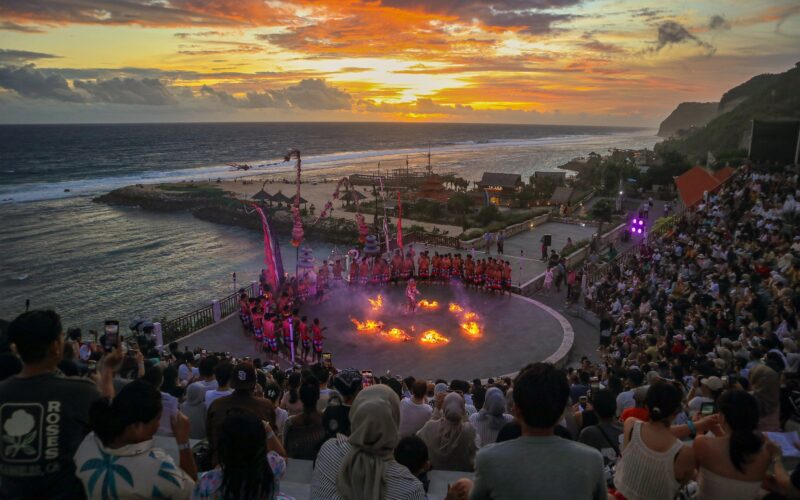Local Traditions & Festivals in Uluwatu

While most people come to Uluwatu for surf, sunsets, and beaches, there’s a deeper pulse that shapes daily life here: Balinese spirituality. From temple ceremonies to silent days of reflection, Uluwatu offers a unique window into the island’s living culture – if you know when and where to look.
1. Kecak Fire Dance at Uluwatu Temple
Held daily at sunset within the stunning cliffside Uluwatu Temple (Pura Luhur Uluwatu), the Kecak Fire Dance isn’t just a tourist show—it’s a ritual rooted in the Ramayana epic. Dozens of bare-chested men chant in trance-like rhythm while Hanuman leaps through flames.
-
Best time to go: Arrive around 5 PM for the full golden hour experience.
-
Dress code: Sarong and sash required (available at the temple).
-
Respect tip: This is a sacred space, so no flash photography or loud conversation during the performance.
2. Galungan & Kuningan – When Ancestors Come Home
Galungan marks the time when ancestral spirits return to visit their earthly homes, while Kuningan (10 days later) is when they depart again. The streets of Uluwatu transform with penjor (bamboo poles decorated with coconut leaves) and the air fills with offerings and prayers.
-
Happens every 210 days
-
Expect small processions, closed shops, and a peaceful, reverent atmosphere.
-
How to observe: Visit a local temple in the morning, wear a borrowed sarong, and watch from a respectful distance. Locals are usually happy to explain the rituals.
3. Nyepi – The Balinese Day of Silence
Perhaps Bali’s most profound tradition, Nyepi is the Balinese New Year, marked by a full day of silence, fasting, and introspection. No flights, no cars, no lights—even tourists must stay indoors. It’s a powerful moment of collective stillness.
-
When: Usually in March
-
How to prepare: Stock up on snacks, books, and enjoy 24 hours of total digital detox.
-
Day before Nyepi: Don’t miss the Ogoh-Ogoh parade, where massive paper mâché demons are paraded through the streets and then burned.
4. Melasti – Cleansing the Soul Before the New Year
Held a few days before Nyepi, Melasti is a stunning water purification ritual where locals walk in white and gold procession to the ocean to cleanse temple items and themselves. Expect to see this at beaches near Uluwatu.
-
When: 2–4 days before Nyepi
-
Where to go: Padang Padang or nearby beaches
-
What to do: Watch from a respectful distance, no swimming in the water during the ceremony
Tips for Respectfully Experiencing Local Culture
-
Wear modest clothing when entering temple grounds: shoulders and knees covered, sarong and sash recommended.
-
Don’t interrupt rituals or touch offerings—small baskets of flowers and incense found on sidewalks and stairs. Step around them, not over.
-
Ask before photographing ceremonies or locals in traditional dress.
-
If invited to attend a ceremony, say yes! It’s one of the most authentic ways to experience Bali.
Plan Your Visit: When to Come for Culture
If you’re planning a stay at Melati Villa, aligning your visit with a major festival or ceremony can turn a relaxing trip into a deeply memorable one.
-
Best time for temple ceremonies: April to October is Bali’s dry season, offering the best weather and visibility for outdoor rituals like the Kecak Fire Dance and Melasti beach processions.
-
For Galungan & Kuningan: These spiritual holidays happen every 210 days based on the Balinese Pawukon calendar – check upcoming dates in advance. The entire island transforms with decorations and offerings, and Uluwatu temples are especially beautiful during this time.
-
For Nyepi: Plan to arrive at least two days before Nyepi (usually in March) so you can experience both the vibrant Ogoh-Ogoh parade and the powerful silence that follows.
-
Avoiding surprises: Many shops and restaurants close during major ceremonies – great for immersion, but best to know ahead. We’re happy to help coordinate dates or adjust itineraries around festival periods.
By choosing your travel window thoughtfully, you can experience Uluwatu not just as a destination, but as a living culture with deep roots and open hearts.